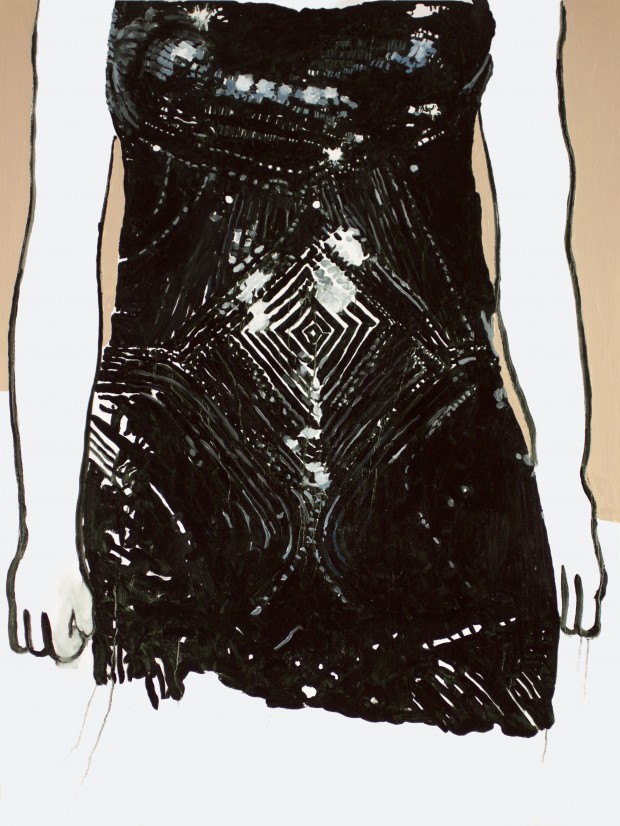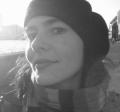You have no items in your cart. Want to get some nice things?
Go shopping
Frith Street Gallery is a large, airy space: polished concrete floors, rough concrete pillars, white walls and lots of natural light. I walk around the summer show and wonder how to make sense of what I am seeing. It is a group show called Mirror. Ostensibly it is about portraiture and yet it is about so much more. It is portraiture in the age of the selfie: portraits of the vernacular, of the ordinary and of the extra-ordinary. It is not portraiture commissioned by wealthy patrons to big themselves up. These are portraits from the inside, from the point of view of the people who make them. The four artists in this show, Fiona Banner, Mohamed Bourouissa, Victor Man and Margaux Williamson, ricochet off each other. There is a dialogue of sorts – a very 21st century dialogue – of texts and ideas echoing and conflating with old-fashioned conversations.
The first piece you see upon entering is Fiona Banner’s eponymous work, Mirror (2007). This very short film plays on a monitor so small you need to get up close. You find yourself peering at the actress Samantha Morton who is reading what appears to be a poem:
Nails shell pink…
Thin papery arches exposed …
Arse moon white…
Dusty hair …
Magnolia hips …
Hand, darkest full stop …
Tulip face …
Eyes like jewels, a comma above each.
The words are Banner’s from a written life drawing of Morton. It is poetry as striptease. The language with its originality, playfulness and awareness of formal elements (notice the full stops and the commas) is a recurring language in Banner’s work. Morton hadn’t read the text before stepping onto the podium. Her delivery is simultaneously halting and moving. She is not only baring herself, she is baring herself as someone who has been seen, uncovered and remade into words. Like so much of Banner’s work, the layers can be peeled and unpeeled and still there is more to be revealed. The final twist in this tale is that Banner and Morton had agreed not to film the performance. However, an email appeared from someone who said they were setting up their camera to film something else and managed to capture some of Morton’s reading. This snippet feels illicit and fragile – it is a portrait we feel we should not be allowed to see but the voyeur in us is utterly seduced.
Just beyond this, are four small works on paper by the Romanian-born Victor Man. These are simple pencil drawings of women’s heads, two of which are double-sided. Taking one off the wall to look at its reverse, I am reminded of Victorian letters in which the correspondents wrote upside down between existing lines so as to save on postage. There is economy to these portraits in scale and in execution. The other piece by Man in the show is Pagan Space (2010) an oil painting of an exploded pagan idol. The falseness of idolatry is exposed as the artist removes all solidity, except that of the oil on canvas itself. The colours here, in line with the sombre palette of this show, are muted and earthy. Molecules or globules float upwards with echoes of talismans in the background. Victor Man’s work displays a deceptive elegance which is shot through every piece in this exhibition.
Perhaps unsurprisingly for a show about portraiture, paintings share equal space with photography and conceptual work. The other painter in the show is Margaux Williamson. Her fresh and almost naïve canvases belie a profound simplicity. In I thought I saw the whole universe (Scarlett Johansson in Versace), we are confronted with the actress’s sequined torso refigured as a monochrome night sky. An eerie incandescence emanates from within this painting. The idea of our world being overseen by a night sky populated by both celebrities and celestial bodies is both very profound and very much of the moment. Pop culture here becomes an homage to painting. It is a very beautiful object, which does not rely on irony or artifice to create its many levels of meaning. There is both depth and superficiality in Williamson’s work. She is an artist with the ability to uncannily defamiliarise the ordinary, making it extra-ordinary.
Williamson’s four other works in Mirror similarly employ titles that are like very short short stories. In They blamed the devil for everything, a hand awkwardly strains, caresses, touches a neck. What act of voodoo are we about to witness? Or perhaps it has already happened. Her titles function as a way into her subjects from another perspective to that of the visual. She is stalking her subject like prey and pinning it down from the inside with words and from the outside with paint.
The literary quality of Williamson’s work riffs nicely with Fiona Banner’s. In Banner’s installation Life Drawing Drawings we are taunted by a Perspex display case stuffed with jumbled up dummy books, each one with hand-drawn reproductions of the covers and spines (spines!) of life drawing manuals. This piece is all about desire. The desire to get at these books and touch them, the desire of artists to capture the human body, to reproduce our flesh and make it last forever. I see a connection here with Williamson’s I thought I saw the whole universe – in their exploration of time and desire and intimacy.
The only colour in this generally muted show comes from Banner’s The Vanity Press, a neon ISBN number, hand-modelled by the artist. The number – and therefore the piece itself – is registered as a publication, cleverly conflating and separating the idea of an actual object with the object itself. What else is a portrait other than an attempt at embodying something (a person’s face, a typeface) through its representation?
The fourth artist in Mirror is the Algerian-born Mohamed Bourouissa. His small photo series, Les Voleurs (The Thieves), 2014, has been pasted directly onto the wall like ellipses in a very sad fresco of disenfranchisement. The artist has documented the faces of people who have been caught shoplifting across Brooklyn. These are anti-portraits of those who have been frozen in a desperate, defining act. Their expressions are angry, resigned, sad, hungry, zoned-out and bleached out with flash. Most are photographed holding the objects they have been caught with red-handed: beer and soda are prevalent along with unidentified packaged goods. This is the other side of the consumer society. The one we try not to see. Yet here are the faces confronting us with their need. One is particular haunting: an elderly African American woman, hunched, looks up at us as if not understanding how she got where she is and how we are where we are. Why? she seems to ask us. And we have no answer for her.
This is what art needs to do. To ask questions even if answers elude us. This show is an elegant and witty take on our chaotic, digital world in an age where documenting it is often confused with living it. The curator, Ann Marie Peña, has created a small and intelligent microcosm which explores questions of longing, belonging and the act of making portraits in the age of the selfie. The echoes from these artists who have come at the subject from four very different angles converge to create a visionary ensemble. You can hear the echo in that large, airy room long after you leave. The conversation continues without you.
Mirror continues at the Frith Street Gallery until August 16. See the gallery website for more information.

About Joanna Pocock
Joanna Pocock graduated with distinction from the Creative Writing MA at Bath Spa University. She is a contributing travel writer for The LA Times, and has had work published in The Nation, Orion, JSTOR Daily, Distinctly Montana, the London Sunday Independent, 3:AM, Mslexia, the Dark Mountain blog and Good Housekeeping, among other publications. In 2017 she was shortlisted for the Barry Lopez Creative Non-fiction Prize and in 2018 she won the Fitzcarraldo Editions Essay Prize. 'Surrender', her book about rewilders, nomads and ecosexuals in the American West, will be published by Fitzcarraldo in 2019. She teaches Creative Writing, both fiction and non-fiction, at Central St Martins in London. Some of her writing can be found at: www.joannapocock.blogspot.co.uk and www.missoulabound.worpress.com




